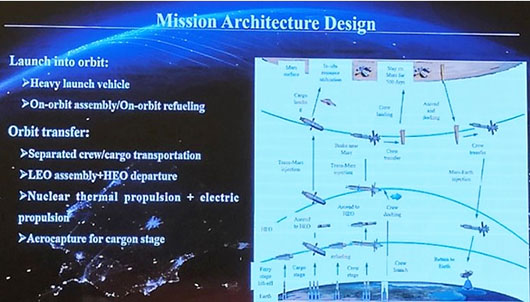Special to CosmicTribune.com, January 3, 2024
By Richard Fisher
The year 2023 was significant for China’s space program on a number of levels, starting with the largest number of space launches — 65 — one more than 2022, while 17 were from new “commercial” space companies (CAS Space, Galactic Energy, Landspace, Space Pioneer, Expace, and iSpace).
China now operates over 290 optical, radar and electronic intelligence surveillance satellites, second in number after the United States, and it plans two or even three new satellite “mega constellations” of thousands of satellites that would rival the planned 42,000 broadband satellites of the U.S. SpaceX “Starlink” constellation.

China launched two 3-man Shenzhou missions to its Tiangong Space Station in May and October, while on Oct. 4 at the 47th International Astronautical Congress in Baku, announced it would double its space station modules to six, which would also allow China to increase its crew to six, supporting more political astronauts from aligned dictatorships.
But 2023 was also significant in that China’s space program targeted deep space to a more specific degree, revealing more about its Moon, Mars and Deep Space ambitions.
This is crucial as the Chinese Communist Party (CCP) has determined that it must be the most powerful actor in the Earth-Moon System and beyond in order to secure its ambitions for broad economic-political-military hegemony on Earth.
In short, for the CCP, securing control of space or at least the ability to deny access to others, is necessary to ensure no future collection of powers can exploit access to space to attack or end the CCP’s hegemony on Earth.
The CCP’s targeting of Deep Space in 2023 took several forms.
At the March National People’s Consultative Congress (NPCC), a display contained the model of the first Chinese Moon Landing vehicle, which for China constitutes a “press release” revelation.
With Chinese official revealing also that their Moon program is now “funded,” and more revelations can be expected in 2024, in addition to the Moon Lander’s ability to carry two astronauts and a small two-passenger carrying Moon rover to the Moon’s surface.
Then on May 29, Chinese state media reported that Lin Xiqiang, Deputy Director of the China Manned Space Agency, announced that Chinese would reach the Moon “before 2030.”
To accomplish this, the 27-ton payload to the Moon China Aerospace Science and Technology Corporation (CASC) Long March-10 heavy space launch vehicle (SLV) may begin testing in 2026, leading to unmanned tests to the Moon.
Early missions will use two Long March-10 SLVs, one to loft a new crew capsule and one to loft the Moon Landing Vehicle, that will dock in lunar orbit with the lander then descending to the Moon.
By 2033 CASC hopes to begin testing its 50-ton payload to the Moon Long March-9, that could first feature a reusable first stage, to be followed by versions with a reusable first and reusable second stage, like the SpaceX Starship.
But well before going to the Moon, China used 2023 to gather its political coalition, the International Lunar Research Station started by China and Russia in 2021, that in April 2023 was extended into the International Lunar Research Station Cooperation Organization (ILRSCO), that by the end of 2023 had seven more members: United Arab Emirates; Venezuela; South Africa; Azerbaijan; Pakistan; Belarus; and Egypt.
Full Text . . . . Current Edition . . . . Subscription Information

You must be logged in to post a comment Login